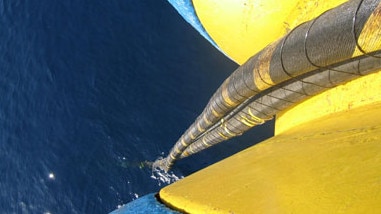Business case says second Bass Strait power cable would be feasible and commercially viable
A business case has delivered a big tick for the proposed $3.5 billion second Bass Strait electricity interconnector.

Tasmania
Don't miss out on the headlines from Tasmania. Followed categories will be added to My News.
THE proposal for a $3.5 billion second Bass Strait electricity interconnector has cleared another hurdle, with the promise of delivering billions of dollars of investment and thousands of jobs for Tasmania.
The business case for Project Marinus has found that a 350km, 1500 megawatt cable would be both technically feasible and commercially viable.
It would enable Tasmania to deliver four times as much hydro, pumped hydro and wind energy directly into the national energy market as coal power stations shut down in coming years.
The business case was jointly funded by the State Government through TasNetworks and Federal Government through the Australian Renewable Energy Agency.
FEDS PLEDGE $56 MILLION TOWARDS SECOND BASSLINK
It predicts the project would create to 1400 construction jobs and up to 2350 jobs in renewable energy generation and storage in Tasmania.
And the project would deliver net market benefits of between $600 million and $3.1 billion and lower mainland power prices once it was in operation.
CASE FOR SECOND CABLE IS STRENGTHENING, SAYS PREMIER
SECOND BASSLINK MIGHT BE RISKY, SAYS INDUSTRY ANALYST
Energy Minister Guy Barnett said the new cable would help Tasmania sell surplus renewable energy and provide storage through pumped hydro as Australia moved away from fossil fuels for power generation.
“Tasmania has what the rest of the country needs — affordable, reliable and clean energy,” he said.
“The cable will help us to unlock significant renewable energy investment in our state, including in pumped hydro and wind.
“The project will also double the telecommunications interconnections between Tasmania and Victoria.”

TOP SITES FOR PUMPED HYDRO OPTIONS
SECOND CABLE UNDERPINS $3B WIND FARM INVESTMENT
The current 500MW Basslink electricity interconnector has been in operation since 2003.
That connector also carries a significant pat of Tasmania’s internet traffic.
An outage from December 2015 to June 2016 that coincided with low dam levels caused an energy crisis.

TasNetworks CEO Lance Balcombe said a new interconnector would be a significant national asset.
“TasNetworks analysis shows that Marinus Link and supporting transmission will support Australia’s transition to a low-cost, reliable and clean energy future,” he said.
“The investment in Marinus Link and supporting transmission will provide additional dispatchable capacity across Bass Strait to support a transforming National Electricity Market.” Mr Balcombe said.
“I’m pleased to announce that the business case is very positive, and shows that a 1500MW Marinus Link and supporting transmission are technically feasible and commercially viable, providing substantially greater benefits than costs under all scenarios modelled and a commercial rate of return to owners as a regulated service.”
A feasibility study released in February was less definitive about the benefits. Since then the size of the proposed interconnector has grown from 1200MW to 1500MW, boosting the case.
At least 12,000MW of coal-fired generation capacity is expected to be retired by 2035, creating an opportunity for the export of additional renewable energy from Tasmania.
The project is intended to be in service by 2027.


